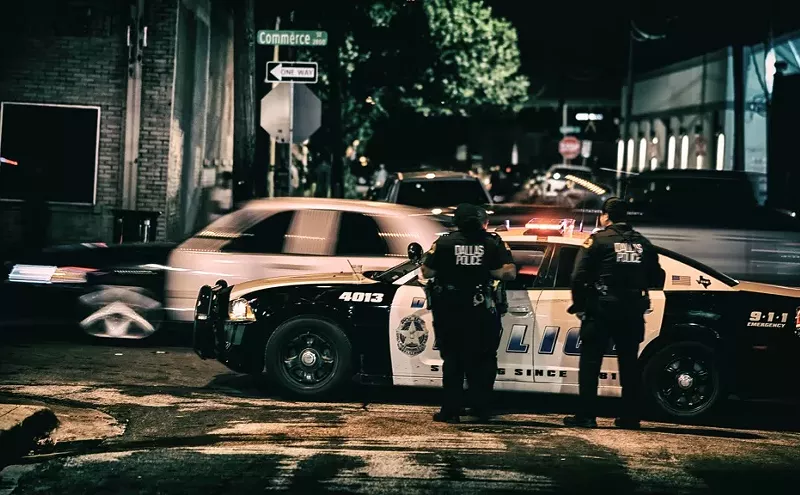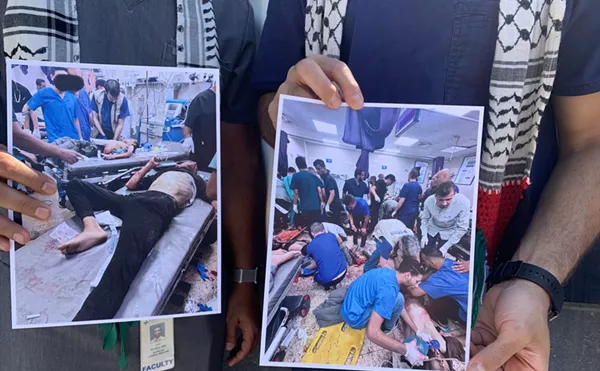For as long as most people can remember, the news out of the Texas borderlands has been anything but quaint—reporters and cops gunned down by cartel hit men, warring rivals beheaded, migrants dying in the desert and political fights over how to stop them from crossing. Public discussion about the boundary that, at least superficially, separates Mexico from the United States tends to focus not on the families and towns that straddle the line, but the illicit people and loads continuously streaming across it.
It's that selective awareness that Benjamin Johnson, an associate history professor at Southern Methodist University, and Dallas emergency room doctor and fine-art photographer Jeffrey Gusky aim to alter in their coffee-table book recently released by Yale University Press. In Bordertown: The Odyssey of an American Place, Johnson's text and Gusky's black and white photographs tell the story of Roma, Texas, at first glance an unremarkable and dilapidated village halfway between Laredo and Brownsville.
Roma has been in the news during the past 18 months as part of the border fence debate, with locals wondering how the wall will affect their properties and fence opponents protesting in fear it will damage farmers' access to water, stifle commerce and hurt Starr County's bird-watching industry. (Roma recently built a birding center a block from the Rio Grande, where tourists can spot the red-billed pigeon, Audubon's oriole and the black-throated sparrow.) Yet with Bordertown, Gusky and Johnson intend to provide a historical and cultural narrative that seems to be missing from contemporary conflicts.
"The book was a way to explore the borderland's identity and history outside the current debates over migration and drugs," Gusky says. "To give the residents a forum to give voice to their sense of place and their contribution to American history."
Noel Benavides, a city councilman whose family has lived in Roma for eight generations, hopes the book will help broaden Americans' views of the border—views which are so limited, he says, that they've led to the construction of 700 miles of border fencing, which will bisect his property along the Rio Grande and which he deems a futile and wrongheaded endeavor to stop migration and drugs. "It's affecting us and it's not going to work. It's a waste of money," he says of the fence. Yet Roma, he says, shouldn't be pigeonholed as a political flashpoint. "Most articles written about the border are pretty sensational. I think this book will help the image of the whole border region," he says. Whether because of its blend of European and ancient Mexican architectural influences, its trade history or the fact that descendents of Spanish Jews fleeing the Inquisition still place stones on the town's grave markers in the Jewish tradition, Benavides hopes Roma gets its due as an American landmark. "People think that just because we're on the border and our skin is brown that we favor Mexico more than the U.S., and that's incorrect," he says. "We're just as American as anyone in Washington or New York."
Johnson, whose work focuses on little-known tales or new takes on old stories of the American West, found in Roma a place that both epitomizes the region's contributions to U.S. history (the proliferation of cross-border trade after the 1848 Treaty of Guadalupe Hidalgo; the complex interactions between Mexicans, newly arrived Anglos and Native Americans) and at the same time, shows a fresh sense of exceptionalism. While in the late 19th and early 20th centuries, people of Mexican descent were stripped of land and voting rights in the rest of the Southwest, Roma's fathers found ways to consolidate and maintain their economic and political power. The hamlet of 11,000 is one of the only towns that since its founding has remained solidly and continuously under Hispanic control.
The book project began four years ago, when Gusky heard Johnson on local public radio talking about his book, Revolution in Texas: How a Forgotten Rebellion and Its Bloody Suppression Turned Mexicans Into Americans, a chronicle of the Texas Rangers' brutal backlash against an uprising by Mexican-born Tejanos. Gusky had discovered Roma while working in South Texas' understaffed ERs, and he was immediately struck by the "the sense of the past in the present" that lingered in the town's cemeteries, wooden doorways and windows, and its 19th-century architectural blend of northern Mexican traditions and modern commercial aesthetics. He called Johnson and proposed they do a book together.
In research and interviews, Johnson unearthed Roma's history and placed it in a broader context that includes tales of Tejano landowners who opted to stay put when overnight their land became America, Anglo Civil War-era scions whose fortunes led to businesses like Citigroup, the descendants of Spanish Jews who still place stones atop grave markers and Southern slaves who flocked toward the border because Mexico abolished slavery before the United States. Johnson's goal is to use such historical fragments to fashion a larger mosaic about American identity itself.
"I wanted to write something that could end up engaging the big debates but also take a step back and tie it to American history," he says. "We talk about the border like it's a problem and not a place. If we realized it was a place, we'd have some appreciation for the people who actually live there. People need to understand that one of the distinct and fundamental parts of our history is that we share a border with Latin America. My intention in the borderlands is to help move us to the diversification of American history, to where the border is an important part of it. This isn't just a story that begins on the eastern seaboard."
Gusky's haunting photographs depict bends in the Rio Grande and clusters of cactus, 19th-century grave markers with engravings in Spanish, overgrown abandoned buildings and architectural flourishes with roots in Aztec Mexico, such as the round flower designs in the moldings of some of the town's brick structures.
Johnson's text illuminates a cast of characters that includes Jose Maria Garcia Saens, one of the town's Mexican founders whose "expansive, self-confident" qualities and ability to bring civilization to one of the continent's severest, most remote places he likens to Anglo pioneers, and Charles Stillman, a businessman from a New England mercantile family who spurred commerce by initiating agricultural trade and land speculation and going into the shipping business with Mifflin Kenedy and Richard King of the vast Kenedy and King ranches. Stillman's profits later grew into what is now Citigroup. Johnson writes about Hispanic residents who aligned against one another on opposite sides of the Civil War, a German mason who settled in Roma and built many of the area's distinctive structures, and Jovita Gonzalez, who was born in Roma in 1904 and defied the racial and gender constraints of her era by becoming a university-educated scholar and writer who chronicled Southwestern folklore.
Luis Alberto Urrea, whose 2004 best seller The Devil's Highway, a nonfiction account of a group of Mexican immigrants lost in the Arizona desert, was a finalist for the Pulitzer Prize, wrote the introduction to Bordertown. He sums up the book as a meditation on the time-worn, complex and often stereotyped rivulets of history and culture that combine to make the border's unique communities and influence the country at large.
"So many depictions of places like Roma, Texas, focus on decadence and debauchery," he writes. "You see the Southwestern borderlands like a tourist passing through hell. This has always seemed unfortunate to me. After all, as the subtitle of this remarkable book points out, they are American places. Haunted by our shared history, alive with the same light as our hometowns."












